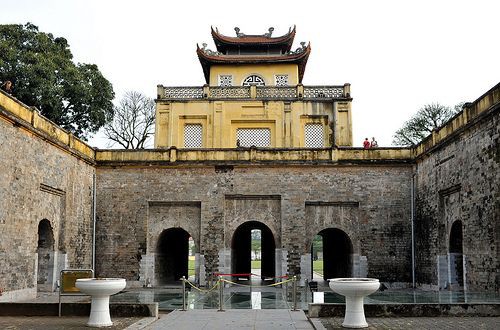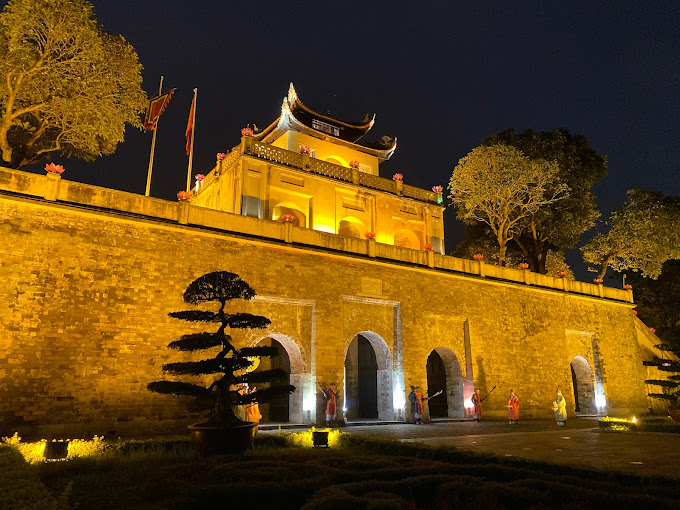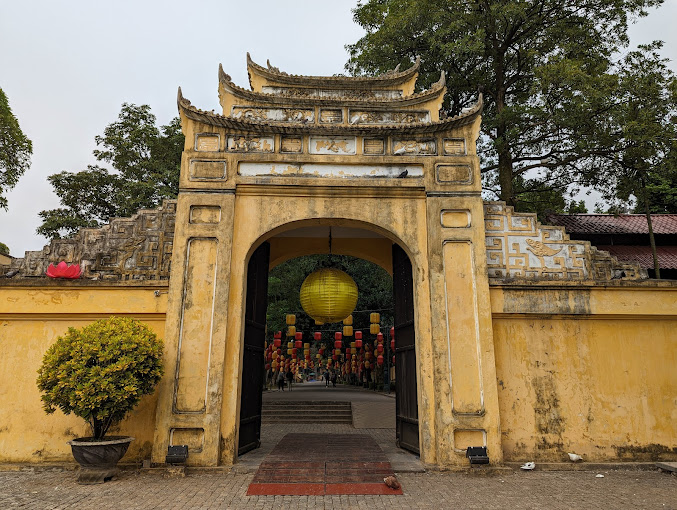What do I like most about traveling to Hanoi? Is it the ancient streets with their golden walls and mossy tiled roofs or the architectural landmarks dating back thousands of years? Is it the refreshing Trang Tien ice cream on a hot summer afternoon or the aromatic bowl of bun cha at a street corner? Besides the architectural beauty, culture, and landscapes, Hanoi is also known as a witness to the ups and downs in the history of nation building and preservation. The Imperial Citadel of Thang Long is a testament to that history.

Let’s explore this special tourist destination with Jackfruit Adventure!
Imperial Citadel of Thang Long – The Golden Heritage of the Vietnamese Nation
1. A Glorious Thousand-Year History of the Imperial Citadel of Thang Long
Originating from the Royal Decree of King Ly Thai To in 1010, the capital officially moved to Thang Long (formerly known as Dai La), and construction gradually commenced. The most prominent structure was the imperial citadel with the model of the “Three Enclosures and Citadel.”

Accordingly, the citadel consisted of 3 layers: La Thanh, Hoang Thanh, and Tu Cam Thanh. Between La Thanh and Hoang Thanh was the living area of the people, while the innermost layer was the residence of the king and the royal family.
After over 1000 years, through the Ly, Tran, Le, Mac, Nguyen dynasties, the Imperial Citadel of Thang Long suffered serious damage from time and invasions. Currently, most of the architecture has been preserved and restored on the old relic foundation. Alongside the surface constructions, the archaeological area is also gradually excavated and opened to the public for visitation.
2. Imperial Citadel of Thang Long – World Cultural Heritage in Vietnam

On July 31, 2010, the Imperial Citadel of Thang Long was recognized by UNESCO as a World Cultural Heritage Site.
Over the past 10 years, tourism activities at the Imperial Citadel of Thang Long have been progressively invested in, emphasizing conservation efforts, and integrating cultural elements through diverse practical activities. This allows tourists not only to witness rare artifacts but also to experience the traditional and ancient atmosphere deeply.
7 Must-Visit Attractions at the Imperial Citadel of Thang Long
The Imperial Citadel of Thang Long covers a total area of up to 18,000 hectares, including prominent structures such as gates, palaces, and archaeological sites. Here are 6 must-visit attractions when you have a flight to visit Hanoi’s Old Quarter.
1. Flag Tower – The Legendary Symbol of Hanoi
Built in 1812, the Flag Tower consists of three main parts: the base, the lookout tower, and the main column standing over 18 meters tall. Currently, the Flag Tower faces Dien Bien Phu Street, surrounded by the green shade of ancient casuarina trees.
When visiting the Imperial Citadel of Thang Long, you must set foot at the Flag Tower to admire this rare and well-preserved structure, which remains intact to this day.
2. Doan Mon Gate
Doan Mon Gate is the innermost (and final) gate leading directly to the Forbidden City area. Currently, the area maintains relatively good conditions and is a must-visit check-in spot when visiting the Imperial Citadel of Thang Long.
Doan Mon Gate has a U-shaped structure made of stone, with a width of about 46 meters and a total of 3 arched doors. Among them, the largest central door is the passage reserved for the king, while the two side doors are for the royal family and court officials to enter and exit the Forbidden City. Above the gate is a lookout tower used to station guards for gate security.
3. Kinh Thien Palace
Kinh Thien Palace is the centerpiece of the heritage site. The arrangement of layers from the inside out follows the order: Kinh Thien Palace – Doan Mon Gate – Flag Tower.
Despite being heavily damaged, the grandeur and magnificence of the palace are still remembered through details such as the huge ironwood columns, each with a circumference equal to that of a person’s embrace (Truong Vinh Ky’s Northern Expedition, in the Year of the Pig). The most prominent feature of Kinh Thien Palace is its exquisite stone carvings, typical of the early Le Dynasty. You can easily spot finely crafted dragon statues on green stone, with full, gracefully curved bodies, raised heads, mouths holding pearls, and large round eyes.
4. Tinh Bac Pavilion
Behind Kinh Thien Palace lies Tinh Bac Pavilion (also known as the Rear Pavilion). Many believe that the presence of this structure holds feng shui significance in maintaining peace in the area. Others suggest that Tinh Bac Pavilion was the residence of court officials in the king’s entourage in the past.
The pavilion, adorned in golden paint with tiled roofs, consists of three floors with a unique combination of Eastern and Western architecture. Thanks to its southern orientation and thick walls, Tinh Bac Pavilion remains cool and airy in summer and warm in winter. The top floor features large windows, allowing for easy observation of the surroundings, ideal for sightseeing.
5. Bac Gate
During the Nguyen Dynasty, a total of 5 city gates were built, one of which remains to this day, known as Bac Gate. Traces of time are still visible on the surface of the gate, with two large marks left by French artillery fire.
Today, Bac Gate is also the shrine of Hoang Dieu and Nguyen Tri Phuong – two Nguyen dynasty governors who sacrificed themselves to protect the city gate until the last moment.
6. D67 House
Compared to other relics of the Imperial Citadel of Thang Long, the D67 area is considered the youngest, built in 1967. This was once the workplace of General Vo Nguyen Giap, General Van Tien Dung, and the venue for many important meetings of the Party Central Committee and Military Commission during the resistance war against the United States.
When visiting the D67 House, you will encounter familiar items that have been preserved to this day, such as maps, desks, chairs, telephones, etc. The nostalgic atmosphere is associated with significant historical events, reminding us of the glorious period of our nation.
7. 18 Hoang Dieu Archaeological Site
Discovered during excavation in December 2002, the 18 Hoang Dieu Archaeological Site is divided into 4 main areas. The most interesting aspect of this site is the stack of continuously preserved relics, corresponding to various periods: Dai La > Dinh – Early Le > Ly > Tran > Ho > Nguyen.
According to archaeological assessments, this is one of the rare archaeological sites that still preserves the layers of relics so consistently.
Other exciting activities at Thang Long Imperial Citadel
In addition to historical relics, when visiting the Thang Long Imperial Citadel, you also have the opportunity to participate in many other exciting activities such as historical exhibitions, art exhibitions, archaeological exhibitions, etc. Especially noteworthy is the “Unlocking the Secrets of Thang Long Imperial Citadel” tour.
This tour takes place at night and lasts for a total of 1.5 hours, departing at 6:00 PM, 6:30 PM, and 7:00 PM every Saturday and Sunday. Although it was only launched in April 2021, the tour has been warmly received by visitors.
During the tour, you will have the opportunity to admire the Thang Long Imperial Citadel in a very different light. With the lighting system and the guide’s narration, you will sequentially visit the prominent landmarks and enjoy traditional dance performances.
Information about the activities of Hoang Thanh Thang Long relic site
- Address: 19 Hoang Dieu Street, Ba Dinh District, Hanoi.
- Opening hours: From Tuesday to Sunday (Closed on Mondays).
- Operating hours: From 08:00 to 17:00. Night tours take place from 18:00 to 21:00 on Saturdays and Sundays

Additionally, the best time to visit Imperial Citadel of Thang Long is around September – November and March – April, as the weather is warm, sunny, with less rain, which is convenient for traveling and sightseeing. You can combine your visit with exploring prominent landmarks in the capital such as Hoan Kiem Lake, Ho Chi Minh Mausoleum, One Pillar Pagoda, etc.
Some regulations to note when visiting Hoang Thanh Thang Long
During your visit, please adhere to some regulations of the relic site, such as:
- Follow the guidance map provided by the relic site.
- Dress appropriately, avoid speaking loudly, and refrain from writing/drawing on trees, walls…
- Maintain environmental consciousness by disposing of rubbish properly, refraining from cutting branches/plucking flowers/stepping on grass.
- Do not carry weapons, flammable substances, toxic substances, or unpleasant-smelling substances into the relic site.
- If visiting as a group, you can contact the relic site to arrange for a tour guide to accompany you throughout the visit.
- The use of flycams is not permitted within the relic site. If you have the need to film or produce videos, please contact the Management Board of the relic site for consideration and permission.
Conclucion
Imperial Citadel of Thang Long stands as a millennium-old pride of the Vietnamese people, a place that bears witness to significant historical events. I encourage you to visit this place once to witness firsthand the architectural marvels steeped in history, learn about its rich heritage, and participate in meaningful activities. Don’t forget to plan for a year of unlimited travel and join in exploring Hanoi with Jackfruit Adventure!




